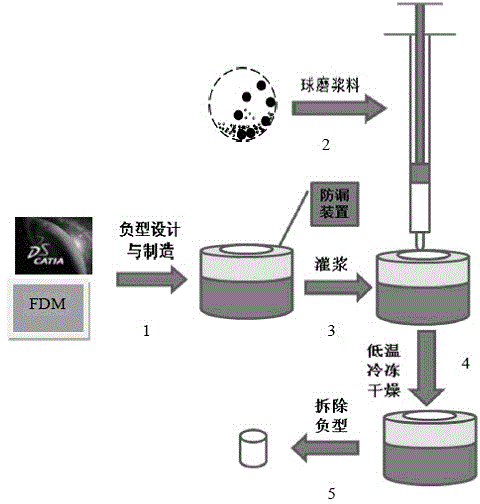Preparation method of nano material-based bionic bone scaffold
A nanomaterial, bionic bone technology, applied in medical science, prosthesis and other directions, can solve the problems of poor mechanical strength, non-degradation, poor toughness, etc., and achieve the effects of improving mechanical properties, easy adhesion, and fast degradation.
- Summary
- Abstract
- Description
- Claims
- Application Information
AI Technical Summary
Problems solved by technology
Method used
Image
Examples
Embodiment 1
[0026] A method for preparing a bionic bone scaffold based on nanomaterials, the preparation process steps are as follows:
[0027] 1) Negative type design and manufacture: The negative type is designed with the help of CATIA V5R19 (France, Dassault System). The shape of the stent determines the macroscopic shape of the stent. The shape of the stent selected in this embodiment is cylindrical, with a diameter of 4 mm and a height of 3 mm. Save the negative three-dimensional solid model in STL format, import it into the fusion deposition molding equipment (FDM300, Stratasys), use ABS as the material, manufacture the negative component, remove the residual wires on the surface of the negative, assemble, and obtain the combined negative of the bracket type mold.
[0028] 2) Preparation of slurry: Dissolve 0.4g of PLGA in 1ml of dichloromethane, then add 1.6g of nano-sized β-TCP, and finally add 4ml of deionized water, and place it in an oscillating mill (MM301, Retsch, Germany), ...
Embodiment 2
[0033] This example is basically the same as Example 1, except that in step 2), 0.6g of PLGA and 1.4g of nano-sized β-TCP are used to prepare a bionic bone scaffold.
Embodiment 3
[0035] This example is basically the same as Example 1, except that in step 2), 0.8g PLGA and 1.6g nano-sized β-TCP were used to prepare the bionic bone scaffold.
PUM
| Property | Measurement | Unit |
|---|---|---|
| diameter | aaaaa | aaaaa |
| height | aaaaa | aaaaa |
Abstract
Description
Claims
Application Information
 Login to View More
Login to View More - R&D
- Intellectual Property
- Life Sciences
- Materials
- Tech Scout
- Unparalleled Data Quality
- Higher Quality Content
- 60% Fewer Hallucinations
Browse by: Latest US Patents, China's latest patents, Technical Efficacy Thesaurus, Application Domain, Technology Topic, Popular Technical Reports.
© 2025 PatSnap. All rights reserved.Legal|Privacy policy|Modern Slavery Act Transparency Statement|Sitemap|About US| Contact US: help@patsnap.com

